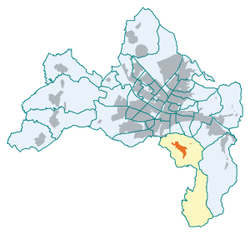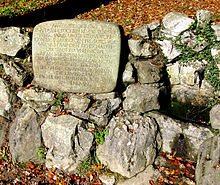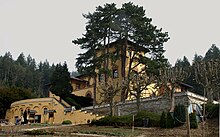User:Oliviaahopee/draft
| This article is currently the subject of an educational assignment. |
Günterstal[edit]
Günterstal | |
|---|---|
District of Freiburg im Breisgau | |
 | |
| Coordinates: 47°57′55.5″N 07°51′26″E / 47.965417°N 7.85722°E | |
| District | Freiburg im Breisgau |
| State | Baden-Württemberg |
| Country | Germany |
| Incorporated | 1890 |
| Divisions | Oberdorf, Unterdorf |
| Area | |
| • Total | 15.10 km2 (5.83 sq mi) |
| Elevation | 330 m (1,080 ft) |
| Population (31st December 2017) | |
| • Total | 2,086 |
| • Density | 138/km2 (360/sq mi) |
| • Proportion of Foreign Nationalities | 14% |
| Postal code | 79100 |
| Area Code | 0761 |
| District number | 43 (Area: 430) |
| Website | www.freiburg.de |
The village Günterstal is the southernmost district of Freiburg im Breisgau. It is located in the so-called Bohrer-Tal area (where the craft of "Deichel-Bohrer", preindustrial wooden water pipes used for the distribution of water, took place) at the foot of the 1284 metre-high Schauinsland in the Günterstal district of the Black Forest. Due to this, Freiburg prides itself on being Germany’s highest city. Günterstal has more than 2,000 inhabitants and is separated from Freiburg by a two-kilometre-wide meadow, the “Wonnhaldewiesen”. The village was incorporated into Freiburg in 1890. The southern neighbouring municipality is Horben.
History of the Cistercian nunnery[edit]
Günterstal is mentioned by name for the first time in a property deed from the year 804, at that time as “Gundherrerhusir” (Houses of Günther) in the march of Merzhausen. Around 300 years later the town reappeared under the name “Guntheristal”. Around 1221, a nobleman, who according to tradition from the 18th century was called Günther of Kibenfels, gave his daughter Adelheid land in Günterstal.[1] There she built a small monastery (monastic attachment?). In a document from 1224, the nunnery was first mentioned in “Gunterstal”. However, Günther von Kibenfels cannot be the town's namesake because “Günter” appeared in the place name much earlier.

The community around Adelheid joined the Cistercian order, which, especially since Bernhard of Clairvaux had also preached in Freiburg, sparked enthusiasm during the Crusade movement. After the death of Adelheid’s father, his other possessions were also passed on to the monastic community, including the “Kibenfels” castle (on the Kybfelsen mountain). A property register from 1344 shows that the nunnery owned properties in 90 villages at the time, including today’s city animal enclosure in Mundenhof. At this time, the municipality of Günterstaal comprised of around 25 houses in addition to other properties. Noble families of the region such as the Küchlin, the Geben, and the Schnewlin made donations to the nunnery. Unlike in a so-called women’s convent, their unmarried daughters entering the nunnery had to transfer all property to the nunnery and provide the abbesses, who also had a seat and voted in the Further Austrian Landstände (estates). In 1486 the nunnery was affected by a flood. The nunnery was also pillaged in periods of war and lost many possessions. In 1632 the nuns narrowly escaped the Swedes by fleeing to the Rheinau Abbey. In 1674 the nunnery, under Abbess Agnes von Greuth, released its subjects from servitude. After the economic situation of the nunnery had improved, in 1727 Abbess Maria Rosa von Neveu decided to replace the old nunnery building with a new building. In the period from 1728 to 1738, a completely new, baroque nunnery complex was built according to plans by Peter Thumb, under the abbess Maria Franziska Cajetana von Zurthannen, who came from the Black Forest and was as pious as she was energetic. Nothing of the abbey survived apart from the portal. Of the formerly rich furnishings of the abbey, only the following are still there: a Holy Blood relic that the Reichenau Abbey gave to the Cistercians in 1737, the associated monstrance from 1738 and the assumed baptismal font in Günterstal. Two side altars are now in the church of Buchenbach, the choir stalls in Kirchzarten, and the confessional in the church of the former Schuttern Abbey. The complex of nunnery buildings and their walls still characterise the town centre today. In 1806 the nunnery was dissolved by the order of Napoleon.
Günterstal nach der Säkularisation[edit]
Die Klostergebäude erwirbt 1812 die Freiburger Firma Mez, die dort eine Fabrik einrichtet. Dies stellt für die Bewohner Günterstals einen großen Einschnitt dar, da die fast 600 Jahre währende Klosterherrschaft das Leben der Dorfbewohner geprägt hatte. Günterstal wird nun eine politisch selbständige Gemeinde. Diese ist jedoch kaum lebensfähig, da ihr entsprechendes Vermögen fehlt. Als „Insel“ innerhalb der Freiburger Gemarkung müssen sich die Günterstäler zum Beispiel an der kostspieligen Erhaltung des Wegenetzes beteiligen. Die Bürgerversammlung beschließt daher den Anschluss an Freiburg, der 1890 durch die Eingemeindung vollzogen wird.
1829 wird das Kloster bei einem Brand fast vollständig zerstört. Zunächst baut die Unternehmerfamilie von Hermann die Klostergebäude teilweise wieder auf und errichtet in ihnen eine Brauerei. 1833–34 wird durch die Badische Regierung die heutige Kirche unter Verwendung von Teilen der barocken Kirchenfassade und von Grabsteinen der letzten Äbtissin und eines Pfarrers an der Außenmauer errichtet und nach und nach neu ausgestattet. Ältestes Stück ist die Madonna mit Kind im Eingangsbereich aus dem 14. Jahrhundert. Aus der 1830 abgebrochenen Kirche des Klosters Tennenbach stammen die Altarmensa und der Tabernakelaufbau von Johann Michael Winterhalder (1706–1759), der auch Schöpfer des Kreuzes an der rechten Seitenwand und der Kanzel ist. Der Kreuzweg stammt von 1863 und wurde durch Wilhelm Dürr den Älteren für die Kirche des Collegium Borromäum in Freiburg geschaffen. Die farbige Fensterverglasung der Freiburger Werkstatt Helmle & Merzweiler wurde von 1885 bis 1902 eingesetzt. Das Gitter im Altarraum stammt von 1888. Die Retabel, die Nebenaltäre und die Kanzeltreppe sind bei der Renovierung 1998 bis 2002 durch Peter Hillenbrand, einen Architekten des bischöflichen Bauamts, unter Verwendung von Fundstücken verschiedener Herkunft neu entstanden.

In der Badischen Revolution von 1848/49 wird Günterstal Schauplatz eines tragischen Gefechts. Der Nachbarort Horben ist die „Operationsbasis“ Franz Sigels. Hier trifft seine Vorhut unter Gustav von Struve auf eine Abordnung aus Freiburg unter der Führung des Studenten Hermann Mors, der berichtet, dass sich die Stadt am 22. April 1848 auf die Seite der Aufständischen geschlagen habe und auf die Freischaren Sigels warte. Entgegen dem ausdrücklichen Befehl Sigels rückt Struve mit seinen 400 Mann über Günterstal hinaus auf den Talausgang beim heutigen Sternwaldeck vor. Dort trifft die Schar auf badische Truppen. Die Hoffnung Struves auf ein Überlaufen der Soldaten trügt. Es gibt ein kurzes Gefecht bei Günterstal, die Freischärler werden in die Flucht geschlagen und bis hinter Günterstal verfolgt. In dem Gefecht fallen etwa 20 Freischärler sowie drei Soldaten. Zweien davon setzen Kameraden am Jägerbrunnen ein Denkmal, das noch besteht.
1892 werden die Gebäude des ehemaligen Klosters von der Freiburger Waisenhausstiftung erworben. Nach der Eingemeindung verbessert sich die Verkehrsanbindung Günterstals durch den Bau der Straßenbahn im Jahr 1901, das Gaststättengewerbe erlebt einen Aufschwung.
Sankt Lioba[edit]

Die Zahl der Höfe verringert sich, neue Landhäuser und Villen werden gebaut. Am nordwestlichen Ortseingang entsteht in exponierter Lage 1906 bis 1913 für den Oberamtsrichter in Müllheim August Wohlgemuth im toskanischen Stil die „Villa Wohlgemuth“.[2] 1927 übernahmen die Benediktinerinnen von der heiligen Lioba das Anwesen.
Siehe auch Kloster St. Lioba
Waldhaus und Forstamt[edit]
Im Herbst 2008 wurde an der Wonnhalde in der Trägerschaft einer gemeinnützigen Stiftung das Waldhaus eröffnet. Mit seinen Angeboten will es neben Schulklassen die Allgemeinheit für das Ökosystem Wald sensibilisieren und für eine nachhaltige Forstwirtschaft werben. Neben Wechselausstellungen gibt es auch ein Café, das sonn- und feiertags geöffnet ist.[3]
In unmittelbarer Nähe erfolgte Ende 2020 der Spatenstich für den Neubau des Forstamtes. Die Stiftung Waldhaus baut dort für rund 2,1 Millionen Euro ein viergeschossiges Holzhaus, in das Ende 2021 das städtische Forstamt aus der Günterstalstraße 71 umziehen soll. Der Neubau dient dann auch der Erweiterung des Waldhauses.[4]
Im angrenzenden Stadtteil Wiehre befindet sich die Forstliche Versuchs- und Forschungsanstalt Baden-Württemberg.
Transport connections[edit]

Tram[edit]
Günterstal has been connected to the town centre by line 2 the Freiburg trams since 1901, which is operated by the Freiburger Verkehrs AG. Most of the rails run next to the “Schauinslandstraße” (Schauinsland street). In Günterstal the tram has three stops: Wiesenweg, Klosterplatz, and the end stop Dorfstraße. Until the end of 2014, when the extension of the cross-border line 8 of the Basel tram to Weil am Rhein was opened, this was the southernmost tram stop in Germany.[5] Now it is only the southernmost tram stop of any German transport company.
Bus[edit]
Bus line 21 begins where the tram terminates, which runs to Horben via the valley station of the Schauinslandbahn during the day. Line 21 runs every 15 to 20 minutes to the valley station of the cable car; every hour a bus runs further up the mountain to Horben.[6]


Ride-sharing benches[edit]
Since 2019 there have been two ride-sharing benches in Günterstal: one at the end stop of the Straßenbahn line in the direction of Horben, and one at the southern town entrance in the direction of the town centre.[7]
Sitting on these public benches indicates that a person would like a free car ride to a specific destination.
Location description[edit]
The district can be divided into Oberdorf, the southern part, and Unterdorf, the northern part, which faces the city. The border passes through the Maximilian-Kobe-Weg to the end tram stop and then runs along the Kuenzersteige.
Oberdorf[edit]
The Oberdorf is loosely built up with villas and other comfortable one-family houses. There is also:
- The Günterstal pond
- The St. Valentin forest restaurant
Unterdorf[edit]
The Unterdorf is closer to the city of Freiburg. In the 2010s two bakeries closed down.[8][9] The next supermarket is on Lorettostraße in the Wiehre district.
Other notable buildings and establishments:
- The Günterstal gate, the former entrance to the nunnery
- The St. Lioba nunnery (formerly the Wohlgemuth villa)
- The Catholic Günterstal Abbey (Liebfrauenkirche), with an adjacent graveyard where many famous people are buried (see below)
- The Evangelical Matthias-Claudius chapel
- The school building, today a Special Education and Counselling Centre with a focus on cognitive development, with the multipurpose hall
- A day nursery[10]
- A variety of restaurants serving simple to sophisticated cuisine; at the Kybfelsen restaurant there is a plaque dedicated to Edith Stein, who came there often
- A Café with a roasting plant[11]
- A petrol station
- A playground with a barbecue area
- The Günterstal youth group
Nature and landscape[edit]


The Russian writer Maxim Gorky wrote about the landscape around Günterstal during his stay in 1923: “We are living in a beautiful, green valley near Freiburg and intend to stay here over the Winter. The vegetation here is interesting, not only because of its colours, but also because of its shapes: thujas, cypresses, various conifers. It is a mild, mountainous landscape…”
The tallest tree in Germany[edit]
The tallest tree in Germany is in Mühlwald, a part of the Arboretum Freiburg-Günterstal,[12] a Douglas fir with a trunk circumference of 300cm at the base, and a height of around 65 metres.[13] It was given the name Waldtraut vom Mühlwald 47°57′12″N 7°51′40″E / 47.953365°N 7.861127°E. In August 2008, the Eberdach Douglas fir was relegated to second place. The measurements of both trees were taken by a measurement team from the Geodetic Institute of the University of Karlsruhe. The measurement in March 2017, commissioned by the municipal forestry office, resulted in a height of 66.581m.[14] The measurement from 19th November 2019 resulted in 67.18m.[15]
Flood protection[edit]
After years of planning and arguments the state of Freiburg promised a subsidy of 8.8 million euros for the construction of a 13.5 metre-high, 275 metre-long, and up to 80 metre-wide embankment dam in the Bohrertal to Horben boundary. A Horben farmer, whose fields were mainly affected, had complained to the Administrative Court in Mannheim against the planning approval decision of the city, which approved the dam in Horben. Nature conservation associations and Freiburg citizens’ associations had also raised large objections to the Bohrertal dam. After the city made replacement land available to the Horben farmer, the legal dispute ended. There are also plans to increase the height of the existing flood control reservoir on the Breitmatte by two metres between the districts of Günterstal and Wiehre. The Mittel- and Unterwiehre citizens' association also resisted this, but no legal steps were taken against it. The ground-breaking for the Bohrertal dam took place in February 2020, and construction on the Breitmatte should begin in the summer. From the end of 2022, not only should the existing Freiburg districts be protected from a flood of the century by this 19.5-million-euro project, but they are also a prerequisite for the construction of the planned Dietenbach district.[16][17]
Famous people[edit]
- Sepp Allgeier (1895–1968), cameraman and photographer, was laid to rest in the Günterstal cemetery.
- Jonas Cohn (1869–1947), philosopher and educator, lived in Günterstal.
- Richard Engelmann (1868–1966), sculptor, was laid to rest in the Günterstal cemetery.
- Hans Filbinger (1913–2007), minister-president, lived in Günterstal for many years until his death, and was also buried there.
- Hermann Flamm (1871–1915), historian und archivist, born in Günterstal.
- Maria Föhrenbach (1883–1961), founder of the female order of the Benedictines of Saint Leoba OSB.
- Svetlana Geier (1923–2010), literary translator, lived in Günterstal, where she also died.
- Hans von Geyer zu Lauf (1895–1959), painter, was laid to rest in the Günterstal cemetery.
- Maxim Gorky (1868–1936), Russian writer, lived in Günterstal with his partner for several months in 1923 Moura Budberg.
- Rudolf Haufe (1903–1971), founder of the Rudolf Haufe Verlag publishing group, was laid to rest in the Günterstal cemetery.
- Edmund Husserl (1859–1938), philosopher; his ashes were interred in the cementery.
- Wolfgang Kirchgässner (1928–2014), Freiburg auxiliary bishop from 1979 to 1998, lived in the St. Lioba nunnery.
- Friedrich Rinne (1863–1933), mineralogist, was laid to rest in the Günterstal cemetery.
- Lutz Röhrich (1922–2006), folklorist and narrative researcher, first chairholder of the folklore at the Universität Freiburg, lived in Günterstal until his death and was laid to rest there.
- Carl Schuster (1854–1925), architect and painter, died in Günterstal.
- Edith Stein (Saint Teresa Benedicta of the Cross, 1891–1942), philosopher, canonised by Pope Johannes Paul II. and declared a Patron Saint of Europe on 11th October 1998. She lived in Günterstal in 1916, 1929, and 1931/32.
- Hans Thieme (1906–2000), legal historian, was laid to rest in the Günterstal cemetery.
- Hildegardis Wulff (1896–1961), cofounder of the female order of Benedict OSB of Saint Lioba, was buried in the Abbey cemetery of the Benedictine nuns of Saint Lioba.
- Ernst Zermelo (1871–1953), mathematician, was laid to rest in the Günterstal cemetery.
Literatur[edit]
- Josef Bader: Die Schicksale des ehemaligen Frauenstifts Güntersthal bei Freiburg i. Br. In: Freiburger Diözesan-Archiv Band 5, 1870, S. 119–206 (Digitalisat).
- Ernst Dreher: Günterstal. Seine Geschichte von den Anfängen bis zur Klosterauflösung im Jahre 1806. Die Gemeinde Günterstal zwischen 1806 und 1830. Lahr, o. J. ISBN 3-9801383-3-X.
- Ernst Dreher: Die Gemeinde Günterstal zwischen 1806 und 1830 in: Schau-ins-Land: Jahresheft des Breisgau-Geschichtsvereins Schauinsland, Band 114, Freiburg im Breisgau 1995, S. 135–161 (Digitalisat).
- Ernst Dreher: Die Gemeinde Günterstal von 1806 bis 1830 (2. Teil). in: Schau-ins-Land: Jahresheft des Breisgau-Geschichtsvereins Schauinsland, Band 116, Freiburg im Breisgau 1997, S. 253–281 (Digitalisat).
- Karin Groll-Jörger: Günterstal Band 1: Von der Säkularisation bis zur Eingemeindung 1806–1890, Freiburg 2013, ISBN 978-3-935737-26-5.
- Karin Groll-Jörger: Günterstal und seine Matten im Spiegel der Geschichte. Eine Kulturlandschaft und ihre Entwicklung, Freiburg 2016, ISBN 978-3-935737-67-8.
- Karin Groll-Jörger: Der Wurf des Teufels. Von Wundern, Sagen und Märchen in und um Freiburg-Günterstal. Freiburg 2016. ISBN 978-3-935737-68-5
Weblinks[edit]
- Stadt Freiburg im Breisgau
- Kloster St. Lioba - Benediktinerinnen
- Weitere Informationen zu Günterstal
- Bilder Günterstals zur heutigen Zeit
- Bilder Günterstals zur Geschichte des Dorfes
- Ortsverein Günterstal
- Jugend Günterstal
- Zisterzienserinnenabtei Günterstal in the data bank "Abbeys in Baden-Württemberg" (Klöster in Baden-Württemberg) of the Baden-Württemberg State Archives
- Eintrag auf Landeskunde entdecken online leobw
Einzelnachweise[edit]
- ^ Josef Bader: Günthersthal. In: August Schnezler: Badisches Sagen-Buch, I. Creuzbauer und Kasper, Karlsruhe 1846, S. 387–388. (Wikisource)
- ^ Hans Sigmund (2016-08-15). "Freiburg: Wiedersehen: Villa Wohlgemuth in Günterstal". Badische Zeitung. Retrieved 2016-08-15.
- ^ "Home - Waldhaus.de". Retrieved 2020-12-10.
- ^ "Heute war Spatenstich für den Neubau des Forstamtes - www.freiburg.de - Rathaus und Service/Presse/Pressemitteilungen". 2020-12-10. Retrieved 2020-12-10.
{{cite web}}: Invalid|url-status=ja(help) - ^ rm (2014-10-18). "Südwest: BZ-Porträt: Mit der Tram über die Landesgrenze". Badische Zeitung. Retrieved 2016-08-07.
- ^ "Linienfahrpläne: Freiburger Verkehrs AG". Retrieved 2016-08-15.
- ^ Jule Arwinski (2019-08-22). "In Freiburg-Günterstal stehen zwei Mitfahrerbänke, aber niemand hält an". Badische Zeitung. Retrieved 2019-08-23.
- ^ Bettina Gröber (2015-11-27). "Das "Café Hornstein" ist nun Geschichte". Badische Zeitung. Retrieved 2019-02-10.
- ^ Anja Bochtler (2017-03-31). "Orsverein Günterstal diskutierte über Infrastruktur". Badische Zeitung. Retrieved 2019-02-10.
- ^ Bettina Gröber (2016-08-31). "Ins ehemalige „Café Hornstein" zieht jetzt eine Natur-Kita ein". Badische Zeitung. Retrieved 2019-02-10.
- ^ Felix Klingel (2018-07-19). "In Günterstal hat ein Spezialitäten-Café mit eigener Rösterei aufgemacht". Badische Zeitung. Retrieved 2019-02-10.
- ^ Claudia Füßler: Der Herr über den Traum aller Förster. In: Zeit Online, 24. November 2011, abgerufen am 15. September 2020.
- ^ Jetzt ist es amtlich: Deutschlands höchster Baum steht in Freiburg[dead link]
- ^ Simone Höhl: Freiburgs Waldtraut ist der höchste Baum Deutschlands. Badische Zeitung, 21. März 2017; abgerufen 5. April 2018
- ^ Mit Waltraut auf dem Holzweg,Anita Fertl, Badische Zeitung, 21. Juni 2020, abgerufen 22. Juni 2020.
- ^ Jelka Louisa Beule (2019-08-01). "Bauarbeiten für Hochwasserdamm im Bohrertal bei Freiburg starten im Herbst". Badische Zeitung. Retrieved 2019-08-06.
- ^ Simone Lutz (2020-02-07). "Spatenstich für das umstrittenste Projekt des Freiburger Hochwasserschutzes". Badische Zeitung. Retrieved 2020-02-09.
{{de:Vorlage:Navigationsleiste Stadtteile von Freiburg im Breisgau}}
Kategorie:Ortsteil von Freiburg im Breisgau
Kategorie:Ersterwähnung 804
Kategorie:Ehemalige Gemeinde (Freiburg im Breisgau)
Kategorie:Gemeindeauflösung 1890
